Learn how to brew your own easy and delicious hard cider with this simple recipe! Brewing your own hard cider is easy, affordable, and it tastes amazing.
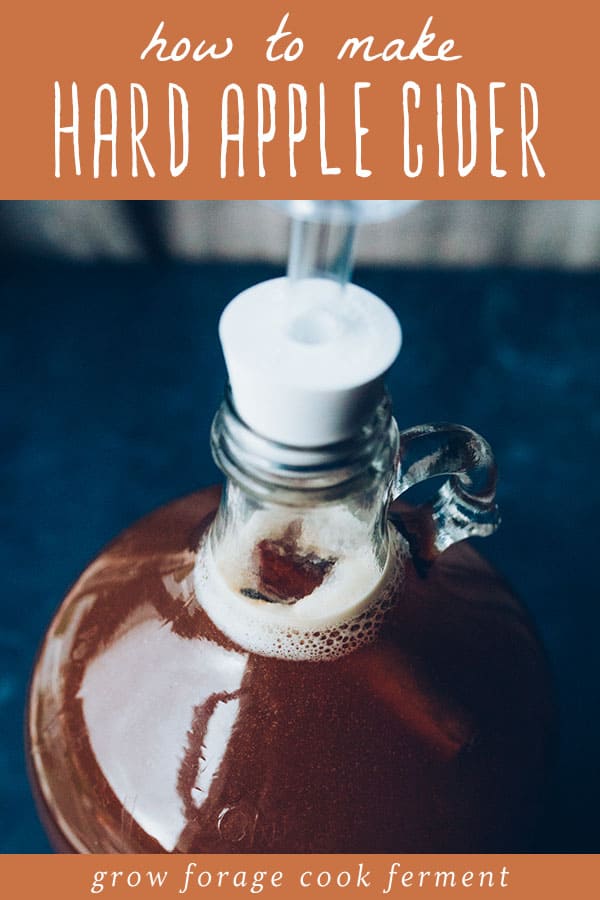
Want to save this post for later?
Homemade Hard Cider
This, right here, will change your world.
No, not in the “this is the best hard cider I’ve ever had, I should sell this stuff and make a bunch of money” kind of way, but in the “Wow, I just made my own homebrew and it’s pretty awesome and maybe I want to learn more about this” kind of way.
I first started making my own alcohol, mainly hard cider and mead (honey wine), when Joel and I lived in a dry county in Arkansas. Yes, dry counties still exist.
I always kept it pretty basic and was usually happy with the results, plus I learned a few tricks along the way.
I even wrote an ebook about Simple Mead Making for Beginners that explains everything in detail, which is a very similar process!
Get recipes for desserts, snacks, breads, side dishes, drinks, and preserving using apples, pumpkins, winter squash, cranberries, and more in my ebook, Cozy Autumn Recipes!
Hard Apple Cider Recipe
I’m going to show you how to make hard cider, which is one of my favorite ways to preserve apples. I think it is the easiest place as any to start brewing your own booze!
You will probably have to buy a few things to get started in your brewing adventure, but don’t worry, everything is relatively cheap. I will go over all of it with you.
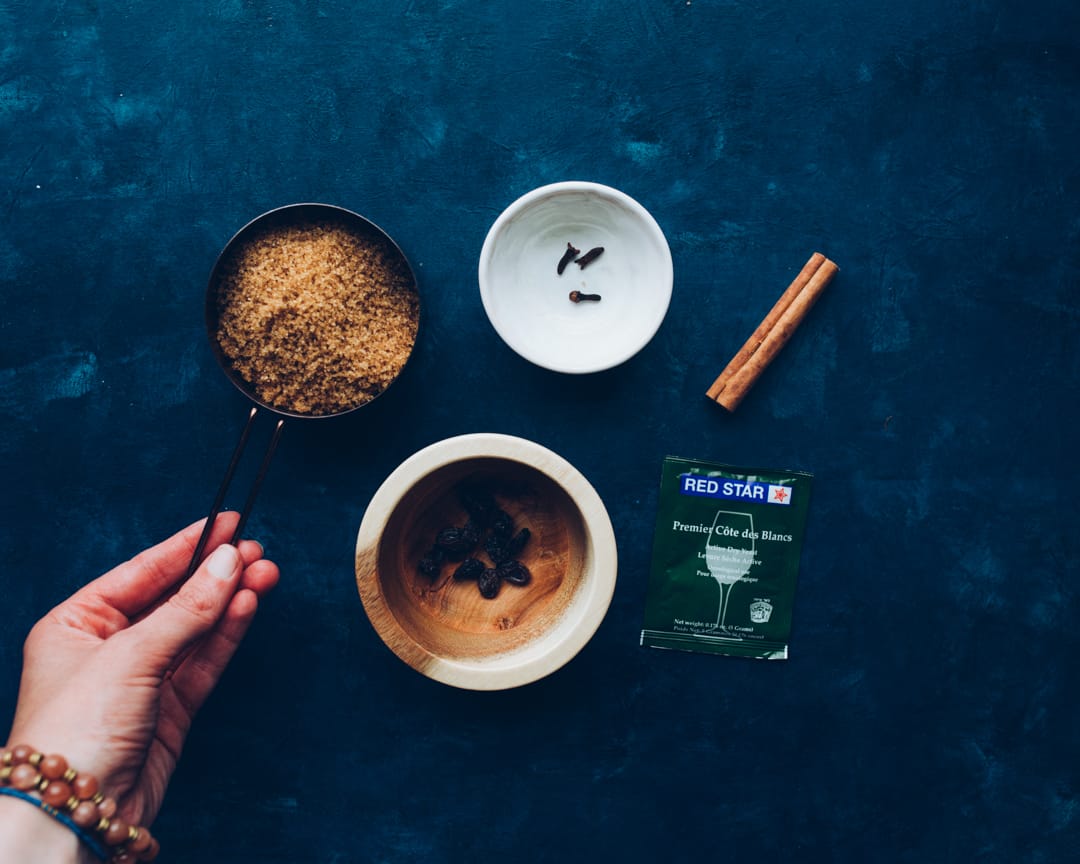
Hard Apple Cider Ingredients & Equipment
I’m going to show you how to make one gallon of hard cider. Here is what you’ll need to begin your brew.
- Sanitizer: This is super important, do not skip this! I like One Step brand as it’s very easy to use and inexpensive.
- A large pot, a big funnel, a big spoon, and a ladle. You may not use the ladle, but it’s good to have it ready in case you need it.
- 1 gallon glass jug with cap and airlock: for fermenting the hard cider.
- 1 gallon apple juice without preservatives: Most preservatives mess up the fermentation (trust me, I’ve made that mistake), but citric acid is ok. I’ve used both Santa Cruz Organic or North Coast Organic brands of apple juice, and they have worked well. Better yet, make your own Apple Cider with fresh apples in the fall.
- 1 pound (16 ounces) brown sugar: more or less, depending on how sweet or dry you want your finished product to be.
- 1 cinnamon stick, 3 whole cloves, 10 raisins: the spices are for flavor, and raisins are a natural yeast nutrient (don’t worry, the raisins don’t impart any flavor on the cider).
- 1/2 package Red Star Champagne (Premier Blanc) or Cotes des Blanc Yeast: (might as well buy more than one, you’ll need them!)
If you’re buying all of these supplies, whether it be online or at a homebrew shop, you might as well get what you’re going to need for bottling as well: an auto siphon with tubing (the mini works good for gallon jars), a bottle filler, and flip top bottles.
I go over how to use these in the post about bottling hard cider.
Sanitize Everything
The first step is sanitizing. It is very important that you sanitize EVERYTHING that will touch your cider.
I usually mix up the sanitizer right in the pot that I’m going to brew in. Just follow the directions on the sanitizer that you have. The one I use is 1 Tbsp sanitizer powder to 1 gallon hot water.

Sanitize the big spoon, funnel, ladle, gallon jug, airlock, and rubber stopper.
Make sure the pot is properly sanitized at the end, and then I usually save some of the sanitizer in something, just in case you forget something or drop your funnel on the floor or your cat lays on your big spoon. It happens.
Brew the Hard Cider
Ok, now it’s time for the fun part!
Put approximately one half gallon of the apple juice into the pot and turn it on medium high to warm it up (don’t boil it).
Once it’s warm, add the brown sugar and stir to dissolve, then remove the pot from the heat.
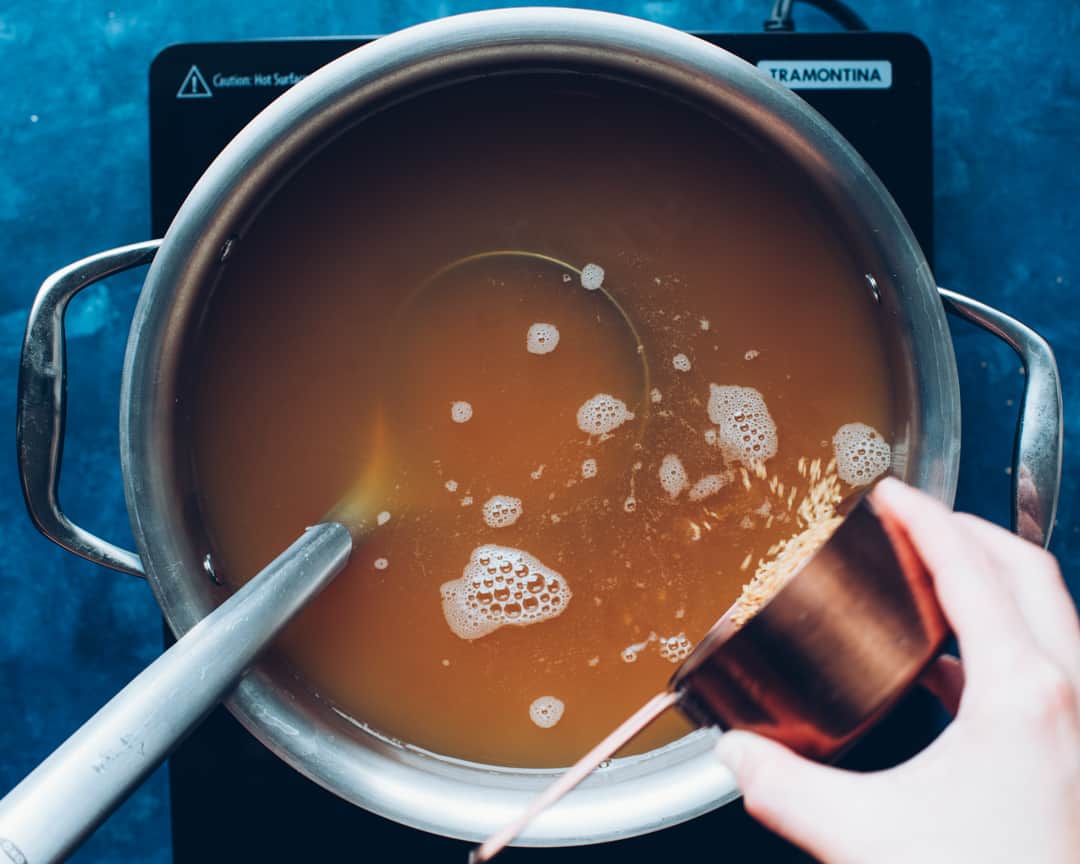
Put the cinnamon stick, cloves, and raisins into the empty one gallon brewing jug.
Use the funnel and ladle to transfer the warm cider from the pot into the one gallon brewing jug. You can alternatively pour the juice from the pot right into the funnel without using the ladle, if you’re feeling brave.
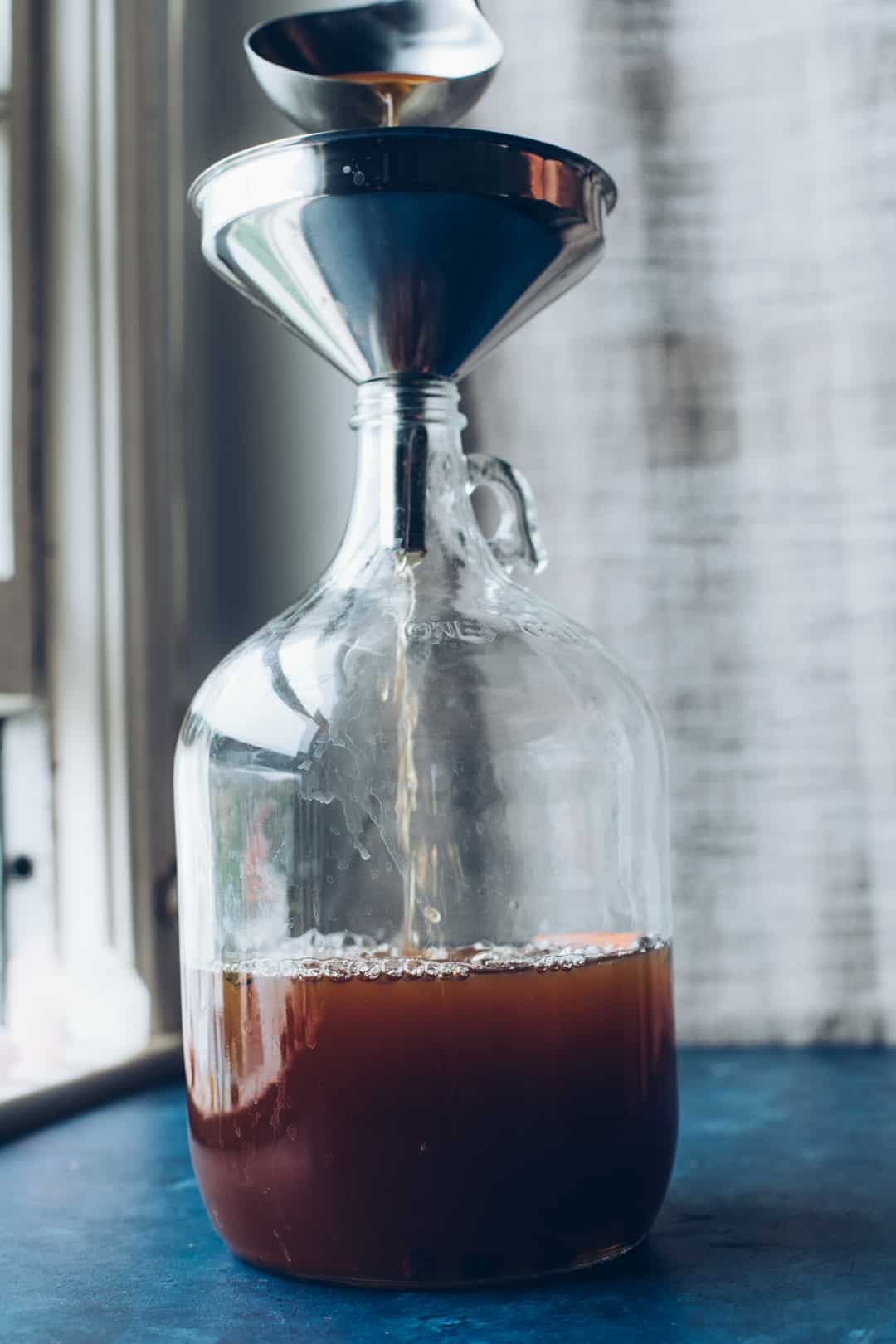
Allow the warm cider to steep with the cinnamon and cloves for about 20 minutes.
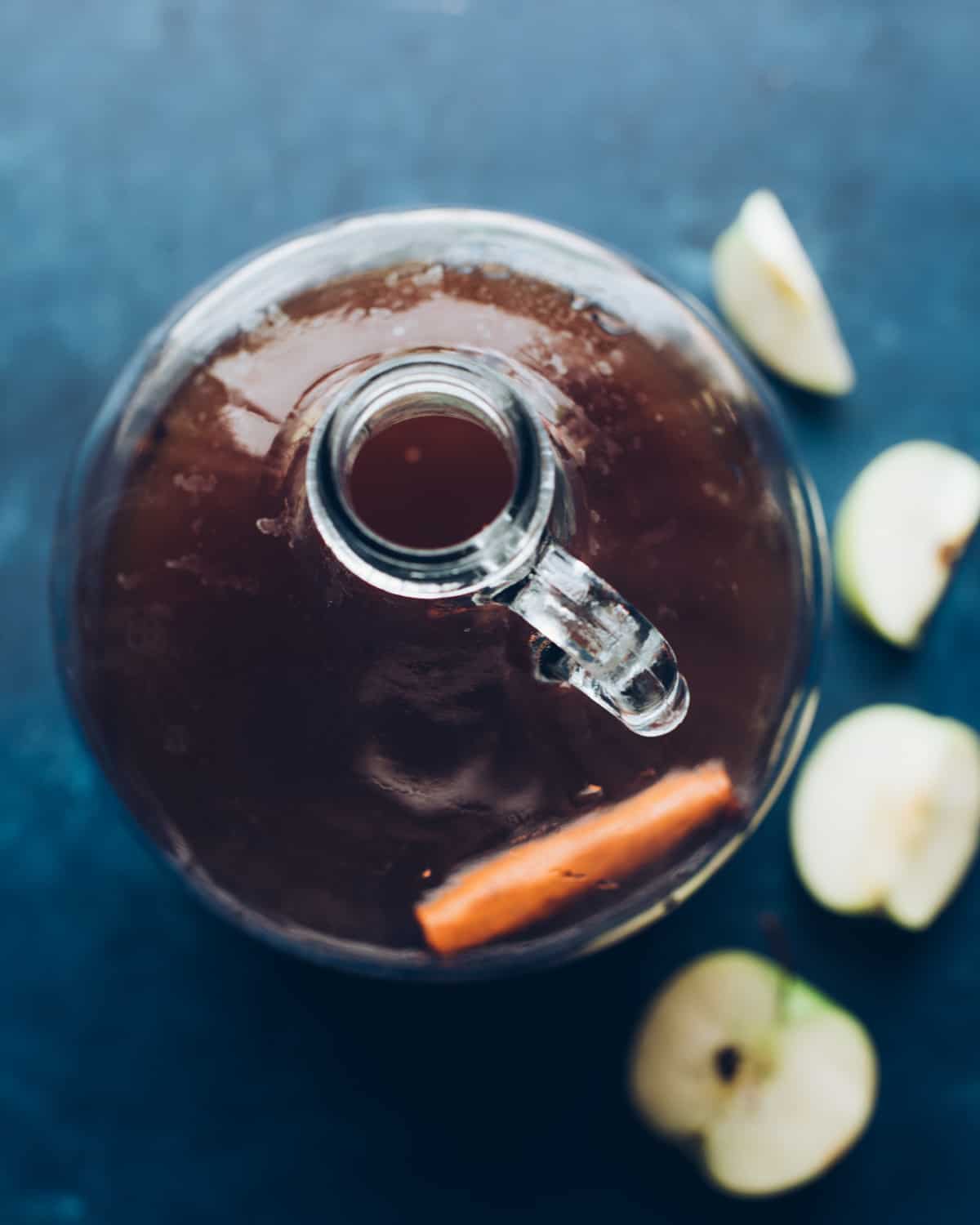
Top off the jug with the remaining ½ gallon of cider, leaving 2 inches of headspace at the top of the jug.
You will have a bit leftover apple juice. Drink it if you’d like, and think about how much better it will be once it turns into hard cider.
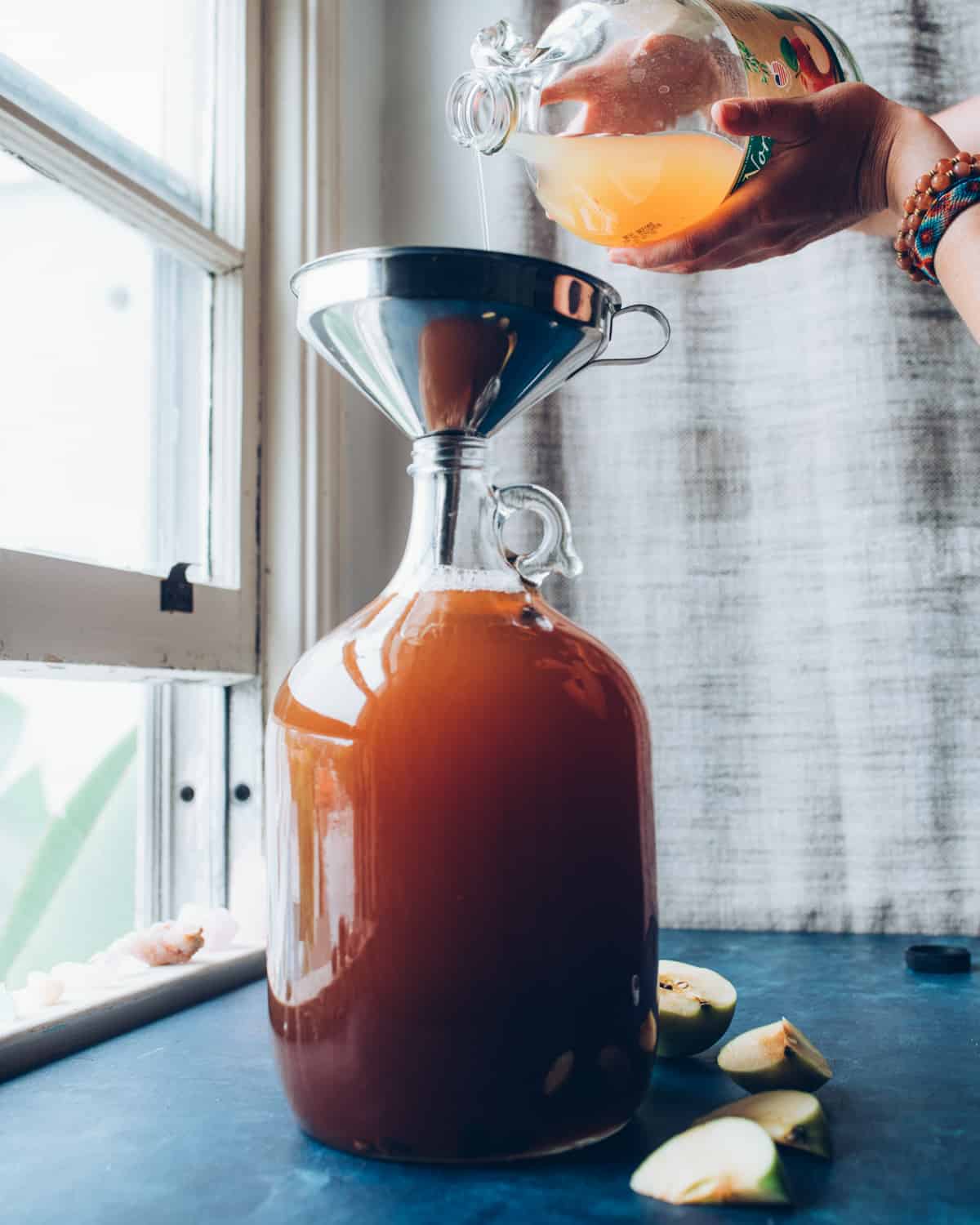
Cap the jug and shake to combine everything.
Use a thermometer to check the temperature of the juice in the jug. When it has cooled to 90°F or less, add ½ package of yeast to the jug (it doesn’t have to be exactly half, just a rough estimate).
Store the opened package with the remaining yeast in the refrigerator for later use. You can actually make up to 5 gallons of brew with 1 yeast packet, so keep that in mind for the future.
Cap the jug again and shake vigorously for about a minute or two to aerate the yeast. The yeast like air, plus you’re distributing the yeast (and getting stronger all at the same time). I usually sing “Shake it like a polaroid picture” while I’m doing it. It helps.
Attach the airlock to the rubber stopper if you haven’t already, fill it with water to the fill line, then place it firmly on the top of the jug.
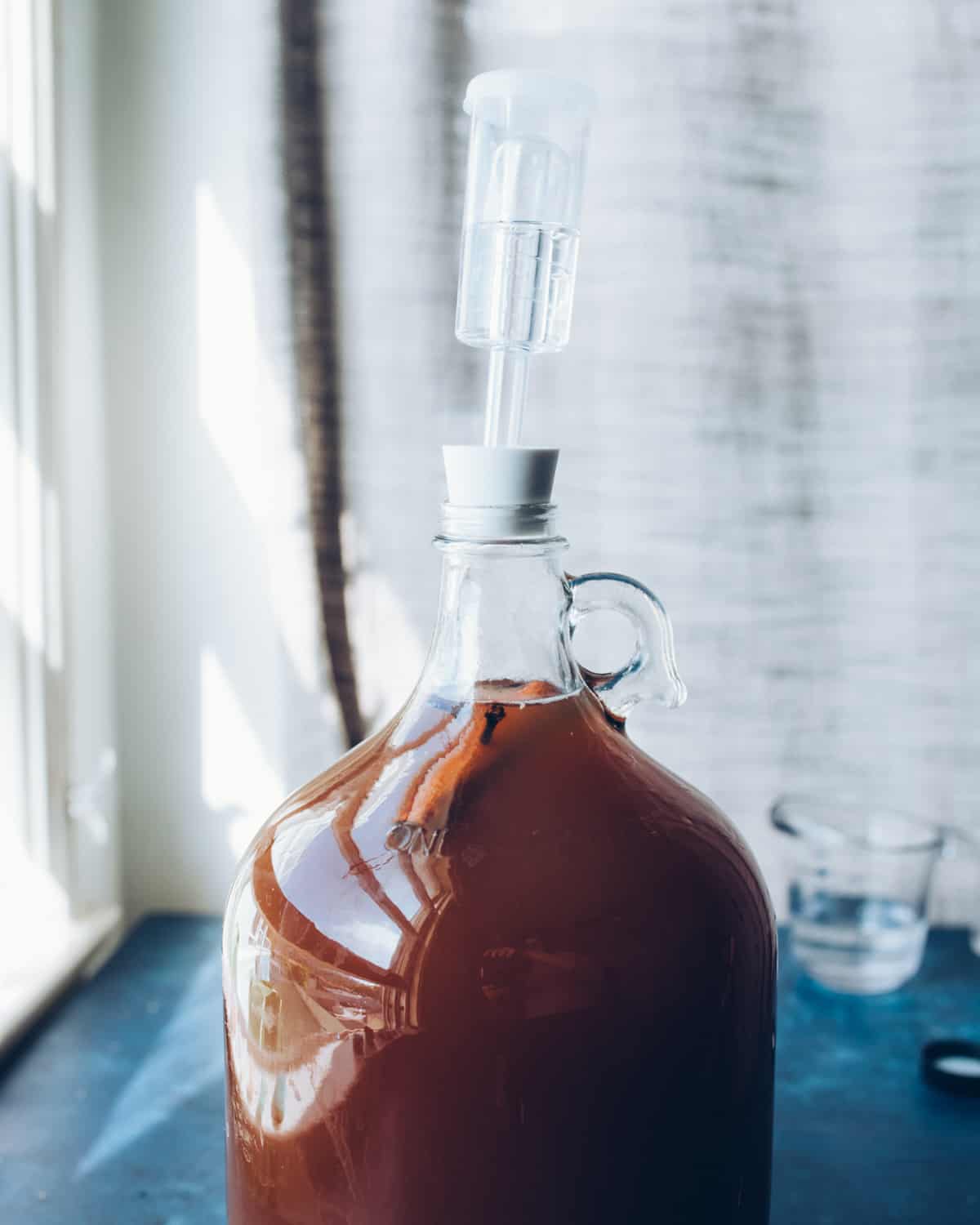
Now, you wait. I know, it’s hard. Put the jars in a cool (not cold) place out of direct sunlight, a pantry or closet is usually good.
In a few hours, or overnight, you will notice some bubbling starting to happen in the jug (yay!). The airlock will start to bubble as well.
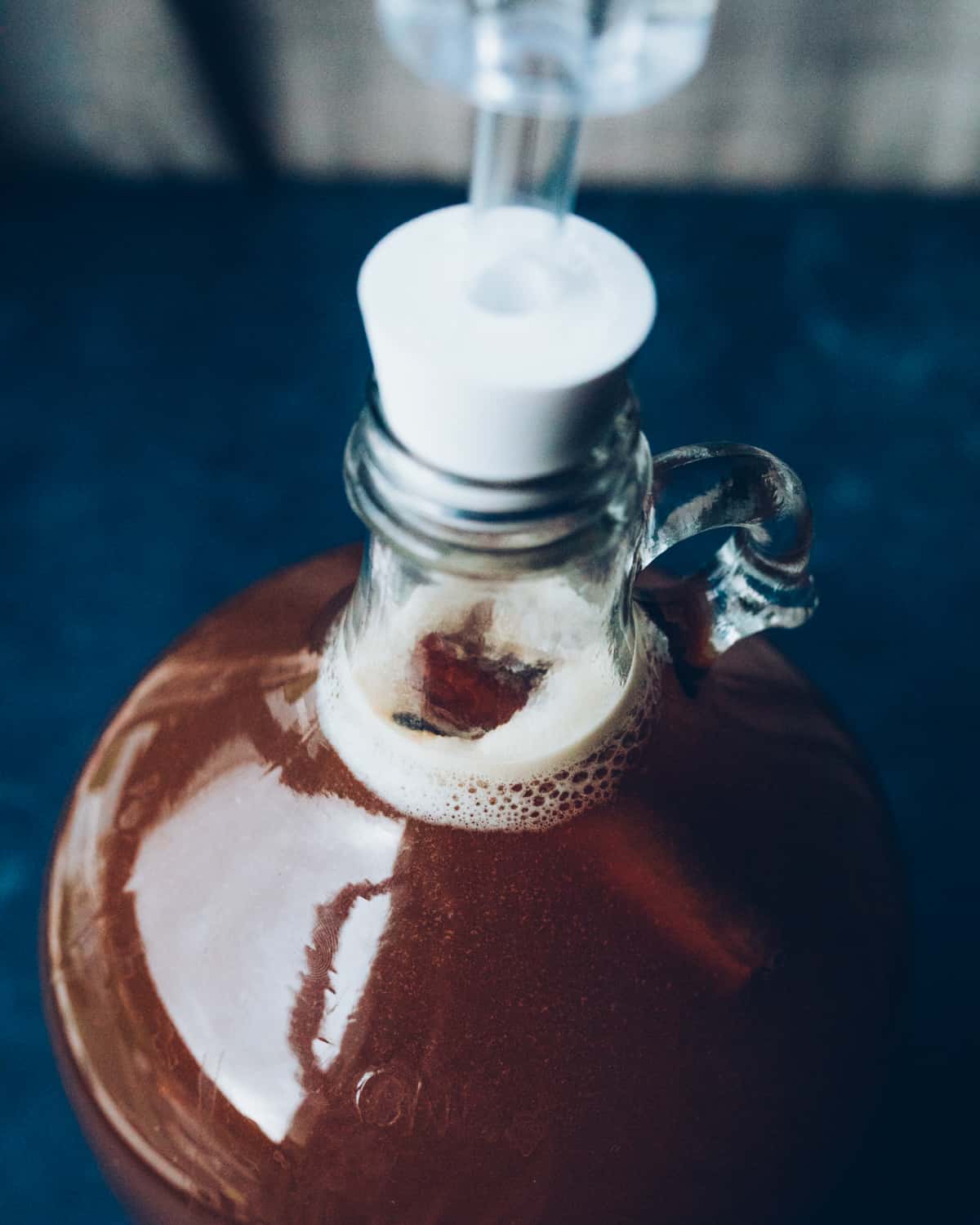
By the following day it should really be going good.
If you don’t see any bubbles after 48 hours something might be wrong. Give it more time, but if you still have nothing after a few days then something is definitely wrong.
The only time I have ever had this happen is when I accidentally used apple juice that had a preservative in it. That was a sad time. Learn from my mistake!
Now just let it ferment until it’s done. You’ll know because it will completely stop bubbling. This can take anywhere from 2-4 weeks, depending on many factors, but temperature is one. When it’s warmer it will be done quicker.
Bottling & Drinking the Hard Cider
Mark on your calendar the day you brew, so that you can keep track of how long it’s been. Once it has stopped bubbling, after around 2-4 weeks, you can bottle the cider with my guide to bottling.
Soon you will be drinking some amazing homemade hard cider!
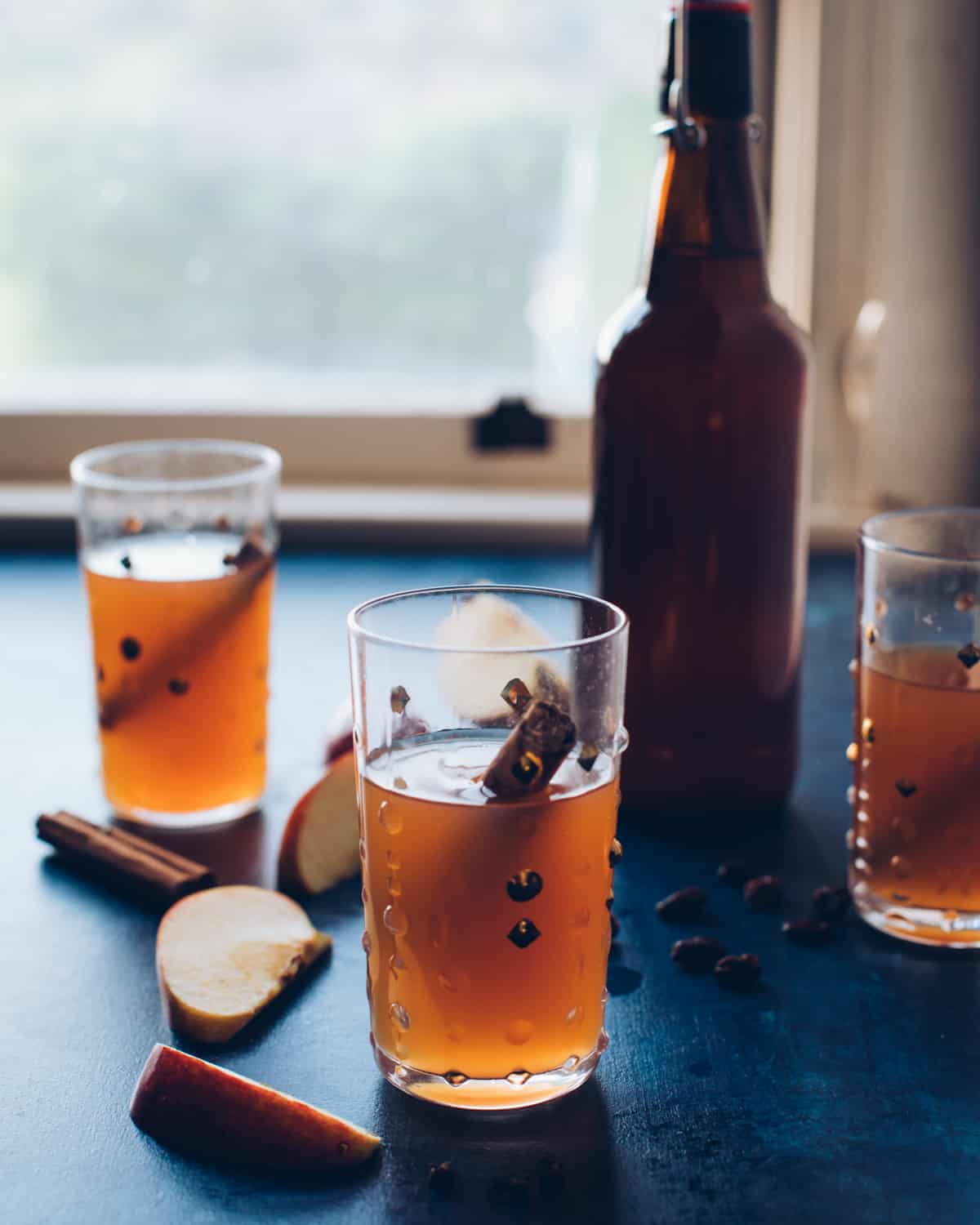
It’s delicious and festive, perfect for fall and winter. The best part is that you made it yourself!
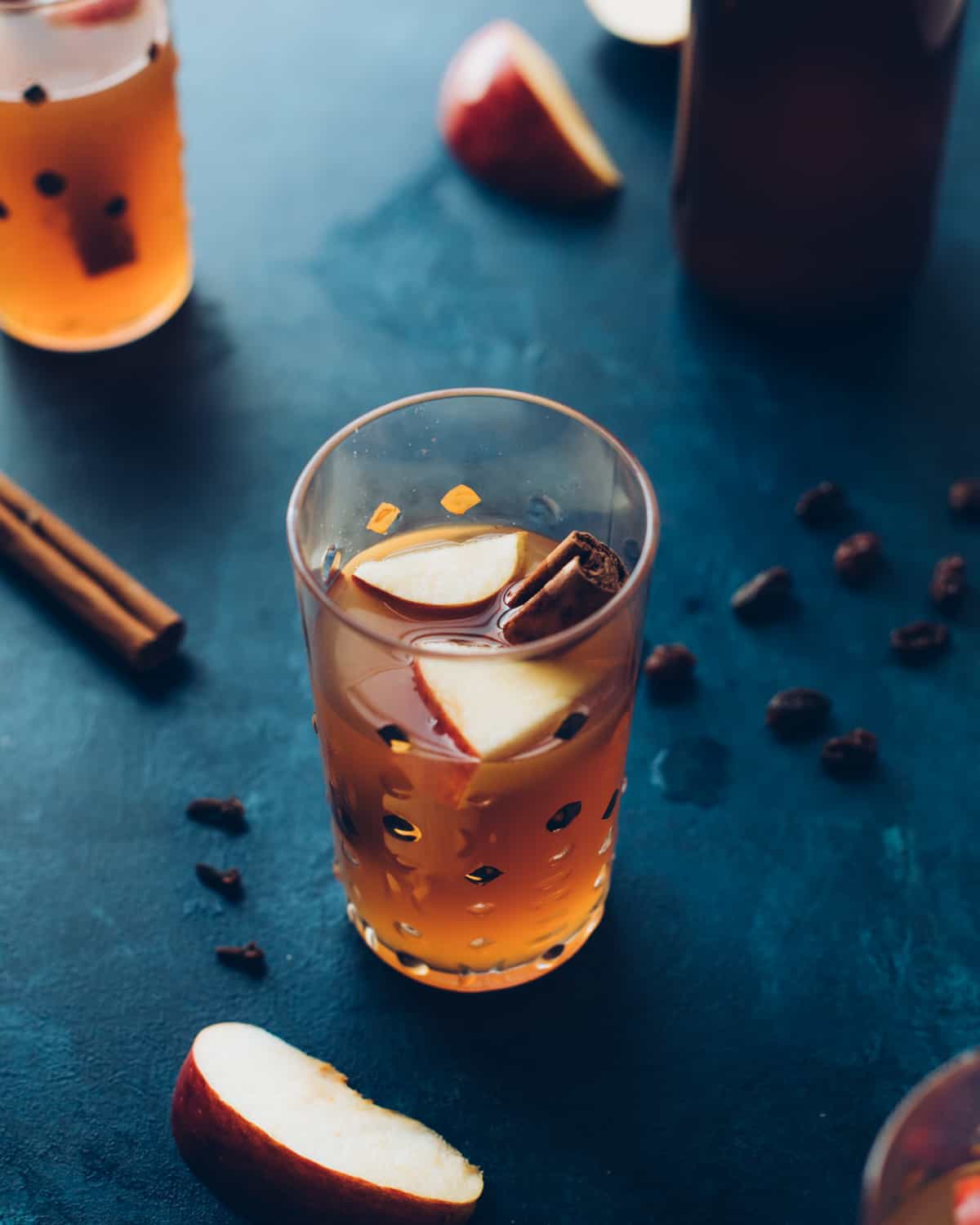
Feeling adventurous? Next time try making your Hard Cider with Wild Yeast. Happy brewing!
Hard Apple Cider
Equipment
Ingredients
- 1 gallon organic apple juice without preservatives
- 1 pound brown sugar
- 1 cinnamon stick
- 3 whole cloves
- 10 raisins
- 1/2 package champagne yeast or cote des blanc yeast
Instructions
- Sanitize everything that will come into contact with your cider.
- Heat ½ gallon of apple juice in a pot on medium heat, do not boil.
- Add the brown sugar and stir to dissolve, then remove the pot from the heat.
- Put the cinnamon stick, cloves, and raisins into the empty one gallon brewing jug.
- Use the funnel to transfer the warm cider from the pot into the one gallon brewing jug. Allow the warm cider to steep with the spices for about 20 minutes.
- Top off the jug with the remaining ½ gallon of apple juice, leaving 2 inches of headspace at the top of the jug. You will have a bit leftover apple juice.
- Cap the jug and shake to combine everything.
- Use a thermometer to check the temperature of the juice in the jug. When it has cooled to 90°F or less, you can add ½ package of yeast to the jug (doesn’t have to be exact). Store the opened package with the remaining yeast in the refrigerator for later use.
- Cap the jug again and shake vigorously for about a minute or two to aerate the yeast.
- Attach the airlock to the rubber stopper if you haven’t already, fill it with water to the fill line, then place it firmly on the top of the jug.
- Put the jug in a cool (not cold) place out of direct sunlight to ferment. After several hours, or overnight, you will start to see bubbles forming in the jug and airlock.
- Allow the cider to ferment for 3-4 weeks, until the bubbling in the jug and airlock has stopped.
Notes
- Preservatives mess up the fermentation (trust me, I’ve made that mistake), but citric acid is ok.
- You can make up to 5 gallons of hard cider with 1 yeast packet, so keep that in mind for the future.
- Fermentation time will be faster when it is in a warm environment.
- See my post How to Bottle Hard Cider when it’s time to bottle the cider.

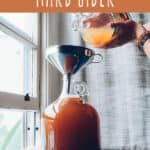
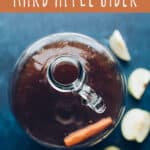
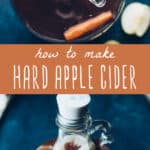
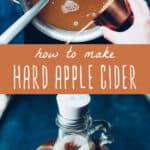
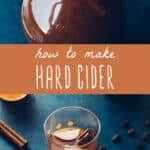
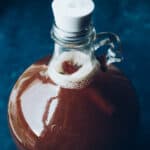

Unless I missed something, how long should I let the cider sit in bottles before drinking (i.e. age)? Do I need to wait or can I chill and drink immediately?
Hi Scott, you can drink it right away if you want. I have an entire post dedicated to bottling hard cider, so check that out!
Love how easy it is, however I had to make mine in half-gallon jugs so I divided everything by 2. Do you think it will still work?
It should!
Thank you for posting this recipe!! QUESTION – I made the cider from home juiced apples, champagne yeast, and let it sit for 3 weeks before bottling. The resulting brew has a strange off odor/flavor, almost like .. tires. Anyone know what i did wrong? or is this right?
How long did you bottle it? I’ve tasted it immediately after bottling and it has never tasted like tires. If it has an off odor/flavor, it sounds like a cross-contamination issue with your ferment and your fermentation vessel or equipment.
I just bottled my first batch of this cider, and it’s delicious. I might use a different yeast next time, as the champagne yeast makes it incredibly dry, but it’s really good none the less. I used a little liquid non-sugar sweetener in the bottle to sweeten it up a tad, but it’s very drinkable straight from fermentation. I can’t wait to try it again in a few weeks after it conditions in the bottle.
the stoppers,are they supposed to fit tight.Ipress them down and they ease back up?
if the stopper or the inside of the jar is wet still from sanitation or cider etc. it can slide back up pretty easy. I personally just make sure both are dry and then keep pressing it down as it comes back up and after like 3-4 goes it usually will hold. I’ve heard people using different varieties of tape to keep it in place however.
When making can you add fresh squeezed orange juice?
Thanks for this recipe, I can’t wait to make this. Do you know what the shelf life might be for the cider once it gets bottled?
I made fresh Perry last year using champagne yeast. Initially it tasted pretty good but over time it has got worse. We bottled it with some sugar to try and get carbonation and really never got much. So I have about 3 gallons sitting it bottles that isn’t that drivable. Do you think I could pour all the bottles into fermentor again and add extra sugar to bring up alcohol? Maybe add some juice concentrate to help improve flavor?
I used the recipe but I made 3 gallons. But it’s no where near sweet enough it’s almost like liquor instead. I there anything I can do to make it more sweet. I hate to waste 3 gallons of juice we pressed our sleves lol from our own tree!! Did I leave it to long? Can I add more sugar and then maybe re rack?
The champagne yeast makes a dry cider for sure. You didn’t leave it too long, that’s just how it is! You can try adding more sugar and re-racking, but I don’t have experience doing that so I can’t give you any specifics. (I prefer my cider to be dry as a bone!)
Add inverted sugar (to taste) at the bottling stage, along with 1/4 cup of cane sugar for 5 gallons. It’ll go back into a secondary fermentation, which will make it sparkling and sweeter.
I made a batch of hard apple cider and I have a question .I have something growing in the jug from the bottom of a raisin . It is about 2 inches long and kinda like a upside down spruce tree . Ever have this happen , or is this normal ?
I like your way of making Hard Cider …I live in Australia and making cider really hasn’t taken off here compared to beer …I take it that your cider is not carbonated ….To carbonate it would you just add a little sugar to the bottles ,the same as carbonating beer.Regards and Thanks …Adrian Knox ( Bugs Bunny )
Hello from northern Canada!! Great post, I’m just wondering what the alcohol content is of this recipe? (I’m looking for a higher percentage) also, is there a way to insure lots of carbonation? Thanks in advance!
I don’t know the exact alcohol content, but it’s probably similar to wine. For a good amount of carbonation you can add a tsp. of sugar to each bottle when you bottle the cider. But beware, as it can sometimes cause bottles to explode!
I made my first batch of hard cider but it came out bitter. I know you said it takes 2 to 4 weeks to ferment and mine stopped fermenting after 9 days, but it was a warm 9 July days…….any thoughts?
It could be caused by the quick fermentation time. I would bottle it and let it age for several weeks, then give it a try again. I bet it will have mellowed out and have a much better flavor.
Hi there, here’s the Netherlands speaking. I just finished the first hard cider part! Can’t wait to give it a try! :-)
Hello!
I have an apple tree and plan on using a juicer to make my own juice. Do I need to do anything special with the apple juice or can I just start following your instructions?
You can just follow the instructions above, it will be fine!
Hey… Thanks for this great article. I’m finishing up my third batch of homebrew, an IPA, and wanted something fairly sweet to balance the other beers I’ve already brewed. So thank you!
Just wanted to clarify a couple things for the sake of ratios. I found the Santa Cruz organic apple juice bottles like I see pictured in your article, but unless I miss my guess, the ones you have are the same ones that I found, which are only 96 fluid ounces, or 3 quarts. I’m planning on using the process you described here, so should I assume that you made 6 quarts of hard cider between the two bottles? Or did you really make two full gallons? I want a sweeter cider, so I want to make sure I get enough brown sugar in the mix so that it doesn’t get to dry.
Also, have you ever tried to harvest wild apple yeast to create a starter? Heard of anybody who has? I’d be very interested in hearing what kind of success you or others have had with that. Thanks again!
I wrote this post a long time ago, and have since discovered that you are right! Those Santa Cruz bottles aren’t a full gallon. They still work great, though. You may want to add a bit more brown sugar than I did to make a sweeter cider. Yes, I have a post on making hard cider with wild yeast right here: https://www.growforagecookferment.com/hard-cider-with-wild-yeast/
What do the cloves add flavor-wise to the cider?
It gives it a flavor of, well… cloves! Haha! Kinda warm and spicy like cinnamon :)
Does adding, say 2.5 cups of brown sugar per gallon make the cider stay sweet? I am trying to avoid a “dry” cider.
There are a few different things you can do to make the cider sweeter. First, I would use a different yeast, as champagne yeast will pretty much always make it dry. I don’t have a whole lot of experience with sweet cider or wine yeasts, unfortunately, so there aren’t any that I can recommend. Adding more sugar at the beginning will help, but you can also do what’s called backsweetening, which is adding a bit more sugar right before bottling. Don’t get too crazy with it, though, as you don’t want your bottles to explode!
I’m having a hard time locating Santa Cruz Apple Juice in my area, do you have any other recommendations for a base?
Hi Aaron, any apple cider will work, as long as it doesn’t have any preservatives. Citric acid and Ascorbic acid are ok, though. I’ve used Musselmans Apple Cider with good results, and I think that Trader Joe’s brand will work as well.
I’ve been buying cider from Azure Standard and just letting it ferment naturally. It gets bubbly and slightly alcoholic. It’s so easy and tastes great!
I do that, too. I’ve never tried bottling it, though. I’d like to try bottling it, since drinking a gallon of hard cider before it turns to vinegar is challenging when it’s just me and my husband drinking it, but I’m not sure the active fermentation would allow for that.
Is there a way to keep the alcohol level low? I’m interested in something with about 2% alcohol.
Hmm, not quite sure about getting it that low… definitely don’t add any of the brown sugar, just ferment the juice straight. I would also look into a different variety of yeast, one that is specifically for a low alcohol content.
I disagree on this one. Changing yeast changes flavor, sometimes a lot. The best method is learning to use a hydrometer to measure the alcohol content. When you reach your desired percentage, add potassium sorbate to stop fermentation. Sample and add sugar/honey if you want it sweeter Anne enjoy or bottle for later.
This sounds great. One question, so the stoppers you linked to DO NOT fit the Santa Cruz bottles? Can you like to a stopper that does fit the Santa Cruz bottles?
I believe that they are a #8 stopper, but let me double check on that.
Are you supposed to let it sit in a dark cool place? Or just leave it out?
Great recipe! Thats what we did with a bunch of our apple crop this year, although some of the results were a little mixed!
Why not use tree top apple cider?
I suppose you could as long as it doesn’t have any preservatives in it, but it’s going to be so much better with real apple juice. I’d say splurge a little for this one!
Thanks you for this recipe! I’ve read so many recipes, that sounded difficult for a beginner, I’m starting a batch of this tomorrow.
Cheers..
our cider just arrived (100% organic), but it”s in 1 gallon plastic jugs, can i brew in the plastic jugs, or should i transfer it to a 5 gallon glass jug?, and as with our wine, instead of a bought airlock, can i use a large balloon with a couple pin holes?, it works just fine for red wine brewing
You can brew in plastic jugs, I’ve seen people do it, but I personally wouldn’t. Plastic scares me! I have done the balloon method and it works fine, but the cost of airlocks is so low that I usually recommend people to get them.
What size rubber stopper fits Santa Cruz jugs? I’ve read size 6, 6 1/2, 8, and that looks like a tiny 3 on the rubber stoppers in the picture.
I’m pretty sure it’s an 8, but don’t quote me on that, haha! There is a number 8 on the ones that I have, so that must be right :)
Could I enjoy this cider right out of the jug, to avoid the step of bottling?
Thank You !
You could, but there will be a good amount of sediment on the bottom of the bottle after it’s finished fermenting that most people don’t want to drink. It won’t hurt you if you do, though! It will be a little harsh at first, but if you let it sit a week or two after fermenting it starts to mellow out a little.
This is awesome! Do you absolutely have to add the sugar? The hard cider I buy from the store is just juice, yeast, and spices, and it is plenty sweet. I can’t wait to use my airlocks and make this :) Thanks for sharing at the Homestead Blog Hop.
Thanks, I’m glad you like it! You don’t have to add the sugar, but the champagne yeast will make it REALLY dry if you don’t. If you aren’t into using sugar for health reasons (I totally understand that) you can use honey instead, and you’ll then be making an apple mead which is called cyser. This cider recipe should almost be called apple wine because the alcohol content is probably closer to wine than store bought cider. It’s really good, though! And, don’t forget, I have Part 2 coming soon that will show you the bottling process.
I’m glad I found the Homestead Blog Hop! I’m pretty new to this whole blogging thing and I really like connecting with like minded people :)
the apple mead sounds wonderful! like a blend of my two favorites! my question is when you replace the sugar with honey, is it equivalent? or does the ratio change?
With any mead I use 2-3 pounds of honey per gallon. 3 pounds of honey is roughly 1 quart.
The sugar is for the yeast to eat, it should almost all be gone by the time your batch stops bubbling.
Is there a difference between buying apple juice and apple cider? The article says “2 gallons apple cider,” but the bottles say “apple juice.”
(That, and I can’t really find apple cider on Santa Cruz Organic’s website.)
No, they’re pretty much the same! Cider and juice are almost interchangeable, either one can be used. I wouldn’t use tree top or anything though :) Just make sure there are absolutely no preservatives (except citric acid) and you’ll be fine!
It can be an English thing. In the UK it’s called ‘apple juice’, and in the US it’s called ‘cider’, then once fermented in the UK it’s called ‘cider’, and in the US it’s called ‘hard cider’.
Ahh now I understand. I was getting myself all confused with the cider/juice terminology. I also thought hard cider was maybe an Americanism for the English rough cider. Thanks for clearing that up 👍
how can you tell when its done?
It will completely stop bubbling. Guess I should have mentioned that! I’ll add that helpful piece of info right now :) Thanks!
Not a definitive way to know by the way… Hydrometer is your friend.